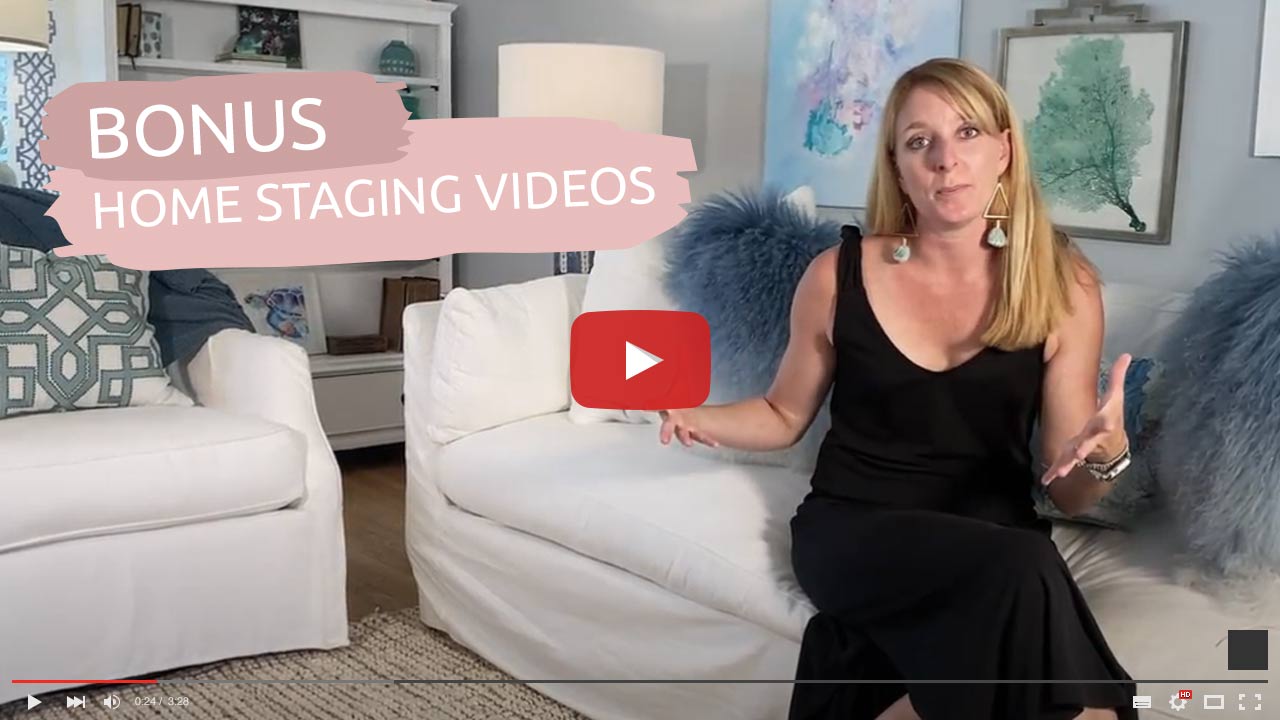How To Become a Home Stager
The ultimate guide on how to become a home stager delivered to you 100% free by the team at The Home Staging Institute.
- Editorial Staff
- May 21, 2025
Take Our Home Staging Course Quiz:
Our course quiz will help you discover which home staging course is right for you...
Did you know that 83% of people visiting the Home Staging Institute are wondering how to become a home stager? That’s not a marketing gimmick – we actually track it. It’s one of the top questions we receive from potential students around the world.
Home staging is a profession that merges the worlds of interior design and real estate.
Many people who choose home staging as a career come from one of these two fields, whereas others have no previous experience in this industry but think they have the right skills to transition into the field.
The good news? This is one of the few careers where you can succeed without a formal degree or years of prior experience. Nearly anyone can become a successful home stager with the right guidance, a passion for design, and a willingness to learn. We’ve had students go from retail work to running a six-figure staging business within a year.
Home staging is booming. Real estate agents increasingly rely on staging to sell properties faster and at a higher price. If you’re passionate about design, love creating beautiful spaces, and want to work flexibly and independently, home staging might just be your dream career.
If you’re serious about becoming a home stager, we encourage you to learn about our online home staging courses
With that said, read our detailed guide on how to become a home stager below. We’ll walk you through every step, from exploring whether staging is the right fit for you, to getting certified, starting your business, and marketing your services. Let’s dive in.
Note: On these type of articles we like to spice up the section images with a certain theme. As you scroll down you’ll see the theme for this article is pastel inspired holiday homes!
How to Become a Home Stager
Step 1: Decide if Home Staging is Right for You

Home staging is a journey worth exploring, at least in our opinion. For those interested in real estate—but not in selling homes—staging is a great way to dive in headfirst and be responsible for how a property makes people feel.
Essentially, you’re not selling square footage. You’re selling the dream.
But let’s not sugarcoat it—home staging is hard work. While many stagers love the design process, there are behind-the-scenes responsibilities you’ll need to juggle, especially if you’re running your own business.
Let’s list some of the tasks you will be involved in while starting a home staging business.
- You’ll need to find your niche. Are you passionate about luxury homes, coastal style, minimalist spaces, or family-friendly homes? One of our students in Florida found her sweet spot staging homes for retirees downsizing from large family homes – she even tailored her services to include decluttering help.
- You’ll need to define your brand. That means a logo, a website, a portfolio, business cards, and possibly even a sign-written vehicle if you’re ambitious.
- You’ll need to price your services appropriately. This includes understanding your time, your value, and what your local market can bear.
Once you’re operating your staging business, you’ll also be handling:
- Managing inquiries. I always recommend turning around quotes within 24 hours. Can you achieve this?
- Relationship nurturing. Being close with realtors can help get a good volume of business through your doors. Can you network, or at least reach out via email to introduce yourself?
- Ongoing marketing. Stagers typically have no “shop front”, so people aren’t going to simply walk on past and enquire. You’ll need to showcase your work via your portfolio on your website, or put out regular content on the likes of Instagram.
- Managing furniture. Will you rent it from other suppliers, or buy your own? Do you have storage, or access to a moving truck?
- Labour. Some bits of furniture you’ll be using will be heavy! Who will support you? Can you hire contractors, or do you have a strong partner (or kids!) to call upon when required?
- Invoicing. Yeah, it can be a bit boring, but it’s the part that gets money in the bank!
Bottom line: If you enjoy creative work, don’t mind a bit of lifting, love a good before-and-after, and are organized enough to manage a few moving pieces, home staging could be an excellent fit.
Step 2: Build Your Foundation

One of the best parts of learning how to become a home stager (at least in our opinion) is the time spent browsing real estate listings in your area
It’s a guilty pleasure that becomes productive – you’ll find yourself mentally rearranging furniture, reimagining layouts, and picking paint colors the moment a new listing drops. And if the listing includes a floor plan? That’s the icing on the cake.
This kind of research isn’t just entertaining – it sharpens your eye and builds your instincts. We always tell our students to start here and see how it feels. If you find yourself naturally spotting what works and what doesn’t, that’s a sign you’re already thinking like a home stager.
In order to become a great home stager, you have to understand what makes buyers tick. Sure, it’s about price, square footage, and proximity to schools. But beyond the checkboxes, buyers are looking for something more emotional: a sense of comfort, security, and possibility. A home that whispers “you belong here.”
You’re not just arranging furniture. You’re setting a mood, crafting a lifestyle, and inviting someone to imagine a new chapter.
A bright, uncluttered home with thoughtful details like flowers, fruit bowls, and neutral colors has a calming, welcoming effect. These choices might seem small, but they’re powerful. Humans are naturally drawn to pleasing environments. Clean lines, natural light, and balanced layouts create a feeling that’s hard to describe – but easy to fall in love with.
On the flip side, clutter, poor lighting, and bold personal decor can ruin that connection. Buyers won’t just be distracted – they’ll be emotionally disengaged. That’s why part of your role is creating a blank slate. Not one that’s cold or lifeless, but one that allows potential buyers to imagine their life in the home, not the current owners’.
One of our students, Taylor from Colorado Springs, made this her entire focus when she first got started. After earning her certification, she committed to visiting 50 open homes in 60 days. She took notes at every one, paying close attention to things like how buyers moved through the space, where their attention landed first, and what design details seemed to impress. That single commitment transformed her instincts and helped her land her first three clients (all before she even launched her website).
If you’re just starting out, we recommend you try something similar.
Pull up listings in your local zip codes and review the photos like a buyer would. Visit open homes whenever you can. Look at the curb appeal, the layout, the way natural light flows through each room. Carry a notebook, or use the notes app on your phone. And yes, bother to actually write things down – it’ll make you better, faster.
If you sign up for one of our home staging certification courses, this is in fact one of the first assignments. You’ll be visiting a couple open homes in your area and telling us exactly what you like, and what you don’t like.
We’re only scratching the surface here, but there are seven main steps that every stager should master if they want to be successful. Each one plays a key role in transforming a home from “meh” to “must-have.”
Let’s run through the essentials:

1. Crafting a detailed staging plan.

2. Help the seller clean and declutter the home.
This is where your emotional intelligence comes in. Sellers are attached to their homes, but you’ll need to guide them in removing personal items, deep cleaning, and simplifying the space. Suggest storing knick-knacks, depersonalizing walls, and even replacing bold paint colors with soft neutrals. If carpets are stained or hardwoods are dull, encourage professional cleaning or refinishing. Every detail matters.
- Bleach and scrub all household tile surfaces in the bathrooms and kitchen.
- Clean and polish the hardwood floors.
- Have the carpets and drapes steam cleaned. If stains persist, counsel the seller to replace the carpets.
- Ditch the dust bunnies and cobwebs.
- Repair wall cracks and holes.
- Re-paint the interior walls. Use neutral colors. Beige, cream or pastels work well in living areas, while bathrooms in blues and greens sell well.
- Remove most of the furniture, especially the oversized pieces.
- Rearrange the remaining furniture to maximize space.
- Clear out closets or at least organize them. Store things off-site.
- Have the seller remove the small appliances, children’s toys, pet paraphernalia, books, and magazines.
- Also, have them pack away and store family photos, collectors’ items, jewelry, and medicines.
- Clean out the garage and put it all in storage if the seller has not yet moved into their new home yet.

3. Maximize the home’s curb appeal.
The front of the home sets the tone. Make sure the lawn is neat, the pathway swept, the front door clean, and the landscaping cared for. A new welcome mat, potted flowers, and working lights can go a long way. Don’t underestimate the power of first impressions – they happen before anyone even steps inside.
- Have the seller paint the home’s exterior, trim, doors, and shutters.
- Double-check the appearance of the front door, welcome carpet, and address number. Check that the doorbell works.
- Power wash the windows and any siding.
- The seller should have the roof inspected. Make repairs if necessary.
- Mow and edge the lawn. Also, water and fertilize it. Trim and shape shrubs and trees. Rake, bag, and dispose of any leaves.
- Sweep the entryway, walkways, sidewalks and repair cracks in any masonry.
- Plant bright flowers and shrubs, if the landscape does not already have them.
- Put any outdoor furniture or toys in storage.
- Clean up pet excrement.
- Clean the home’s gutters and downspouts.
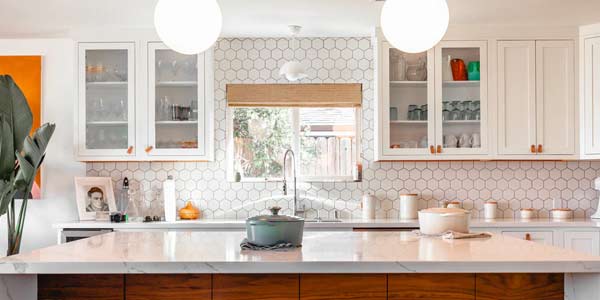
4. Clean and update the bathrooms and kitchen.
These are the deal-makers. Buyers will forgive a dated bedroom, but a grimy kitchen or tired bathroom? Not a chance. Clear countertops, polish fixtures, hide small appliances, and swap out towels and hardware if needed. One student, Jamal from Ontario, started offering a low-cost “kitchen and bath touch-up” package as an entry point for budget-conscious sellers. It worked so well, he eventually turned it into a standalone service and used it to upsell full-staging jobs.

5. Set an appealing ambiance
Open curtains. Add greenery. Bake cookies. Seriously – these things work.
Lighting and scent play huge roles in how buyers feel when they enter a home. Avoid overpowering air fresheners, and instead opt for subtle, natural scents. Replace dim bulbs with warm, high-lumen options and turn on all the lights before a showing. The goal is to make the home feel alive.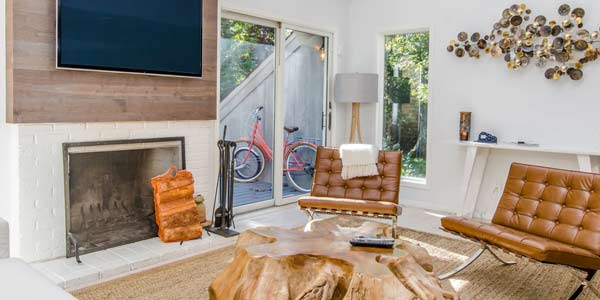
6. Showcase the top features of the home.
You’re not just filling space – you’re drawing attention. If there’s a fireplace, stage the area with cozy seating. If the view is a selling point, make sure nothing obstructs it. One of our students in Chicago made this her specialty, and now leads every staging plan by identifying 2–3 “hero” areas in the home to elevate. These focal points guide how buyers experience the space.

7. Make logistical preparations for your open house.
Even if you’re not the one hosting the open house, you can make sure your client is fully prepped. That includes printing info sheets, tidying up cords, removing signs of pets, and leaving behind a light snack for guests. Encourage your client to leave the house during viewings – buyers feel more comfortable when the owners aren’t around.
Can you picture yourself doing these tasks for a client’s home? How about doing it for three homes a week? If you’re reading this and thinking, “I’d love that,” then you’re in exactly the right place. You’ve got the mindset, the interest, and now the foundation.
Let’s keep going.
Step 3: Understand Your Market

No doubt you’ve already done a lot of research on the home staging business.
But let’s just double-check that all the boxes are ticked.
Before you invest time, energy, or money into your home staging business, you need to understand exactly what the opportunity looks like in your area. Getting clear on this now will save you weeks—if not months—of spinning your wheels later on.
To succeed as a home stager, you need to know who else is out there. What kinds of staging services are already being offered near you? What types of homes are being staged? What are people charging?
Doing this research will give you real-world insight to help you:
- Shape your service packages
- Understand where you fit in the market
- Spot opportunities for standing out
For example, one of our past students in Christchurch realized that every staging business near her was focused on full-service staging for high-end homes. But no one was offering affordable “consultation only” packages. She leaned into that gap, positioned herself as a budget-friendly expert for first-time home sellers, and within a few months had booked over 20 consults. That kind of insight only comes when you know what others are (and aren’t) doing.
Start with Competitor Research
There are lots of ways to get this done.
Start with a simple Google search. Use phrases like:
- “Home staging + [your city]”
- “Property stylists near me”
- “Real estate staging + [region]”
Make a list of every business that comes up. Include their website, social media handles, contact info, and any pricing you can find. Focus on companies within 50km of where you’ll operate.
Pro tip: Go beyond the first page of Google. Some of your competitors may have dated websites but a solid client base. You don’t want to miss those just because they don’t show up first.
If you know any local real estate agents or interior designers, ask them which stagers they recommend. Chances are, you’ll uncover a few names that aren’t ranking well on Google but are active behind the scenes.
One of our students in Austin created a spreadsheet listing 14 home staging businesses within her service radius. She included columns for price, services offered, design style, Instagram activity, and how many 5-star reviews they had. This gave her a competitive edge before she even launched her website. We’re uploading this to the student dashboards for the Professional and Advanced Courses this month for others to use as a template!
Find the Gaps
Once you’ve got a list of active stagers in your area, start looking for trends.
- Are most of them focused on luxury homes?
- Is their style modern, farmhouse, or minimalist?
- Do any of them specialize in partial staging, consultations, or rentals?
If everyone is doing full-service and no one offers “DIY with guidance” packages, you might’ve just found your niche.
A lot of new stagers make the mistake of copying others instead of filling the gaps. If you want to make a splash, aim to be a little different in a way that solves a problem no one else is addressing.
Stalk Their Marketing (In a Good Way)
Once you know who your competitors are, it’s time to see what they’re doing online. Search their brand names across:
Are they active? Are they posting regularly? Are people commenting or liking their content – or is it crickets? If their posts are getting engagement, chances are they’re building a recognizable brand and some word-of-mouth buzz.
Take note of where they’re advertising. Are they listed on real estate directories? Featured on staging blogs or local magazines? Are they running any paid ads?
You can use the Facebook Ad Library to see if they’re currently running ads on Facebook or Instagram. This is a brilliant way to gather inspiration and understand what’s working in your local market.
If you’re signed up to one of our home staging courses, use the contact form in the learning dashboard to ask us about our sneaky methods that we don’t publish here – they’ll save you time and give you better insights.
Understand Their Pricing
One of the top questions we get from new students is, “What should I charge?”
The truth is, it depends entirely on your location. A two-bedroom staging in Los Angeles will cost more than the same job in rural Ontario. You’ll need to set your prices based on the average home value in your area and the type of clients you plan to attract.
But competitor research helps here too.
Roughly 20% of staging businesses publish some form of pricing on their websites. For those that don’t, you can always send a pretend inquiry using your partner’s or friend’s email address. Something simple like:
“Hi, we’re looking at staging a 3-bedroom, 1-lounge home nearby. Could you send us your pricing info to help us decide?”
This will give you real quotes to compare against. You can also use our home staging pricing calculator tool.
One site we looked at this morning had these rates:
- Essentials Styling Package – From $2,200
- 2-Bedroom Styling – From $2,600
- 3-Bedroom Styling – From $3,200
- 4-Bedroom Styling – From $3,800
- Partial Styling (priced on inspection) – From $1,800
The word “from” is key here. Prices go up depending on how many rooms are being staged, the size of the furniture required, and whether things like curb appeal and exterior spaces are being touched.
And remember: don’t undersell yourself just to land jobs. One of our Canadian students made that mistake early on – charging far less than her time and travel were worth. After she raised her rates by 25% and created service tiers, she found she actually got more inquiries, not fewer. Why? Because her new pricing aligned with the professional image she was presenting.
So before you launch your business, do your homework. Know the market, know your competitors, and know the pricing expectations. With this groundwork laid, you’ll be able to position yourself smartly, price your services confidently, and stand out in all the right ways.
Ready to dive into the next step? Let’s talk about getting properly trained and certified as a home stager.
Step 4: Take a Home Staging Certification Course

Every aspiring home stager eventually hits a fork in the road: Do I need a home staging certification? Should I take a course? Is it worth it?
Let’s clear it up.
No, you don’t legally need to be certified to become a home stager. There are no government regulations in the United States, Canada, Australia, New Zealand, or the UK that require you to hold a qualification to start staging homes.
But – should you get certified anyway?
Yes. And here’s why.
A home staging course like those we provide here at the Home Staging Institute helps you avoid the long, expensive process of trial and error. It gives you structure, teaches you exactly what works (and what doesn’t), and builds your confidence in real-world situations. And when it comes to landing paying clients, being able to show you’ve been trained by a trusted, recognized name in the industry can tip the scale in your favor.
At the Home Staging Institute, we’ve been providing online training since 2006, and thousands of students from around the world have completed our courses. Most are in the U.S., but we’ve also had plenty from Canada, Australia, the UK, and even students in countries like Germany, Japan, and South Africa. In fact, students form over 50 countries have been guided by us to start their home staging businesses!
We’ve had students with zero design experience land paying clients within a month of completing our Professional Course. One of those students, Claire, was in Vancouver working as a dental assistant when she enrolled. She staged her sister’s home as her “final project,” used those photos to build a portfolio, and by Week 6 had secured her first real estate agent referral. She now runs a full-time business and tells us that certification was the credibility boost that gave her the push she needed.
If you’re starting from scratch, our certification courses walk you through everything – from how to conduct a consultation, to setting your pricing, to marketing your services online. The first few units are light and easy, and by Unit 3, most students feel confident enough to begin offering staging consultations, even if only to friends or family at first.
Certification also acts as a powerful marketing tool. Clients want to know that you’re not just passionate – you’re trained. They want to see some evidence that you’ve done more than scroll through Pinterest boards and HGTV episodes. When you can say, “I’m certified through the Home Staging Institute,” you’re giving them peace of mind.
Another recent student, Jake in Florida, said he included his certification badge on the homepage of his website and got three inquiries within two days. He hadn’t changed anything else – just added the badge. It created trust instantly.
So yes, while certification isn’t legally required, it’s an easy win – a small investment in time and money that gives you professional training, credibility, and a structured path forward. Our Professional and Advanced Courses include a short exam and, upon passing, a downloadable certificate that you can use on your website, social media, and marketing materials. The courses range from $197 to $498 – super affordable!
If you’re still deciding whether this career is right for you, enrolling in a certification course is one of the fastest ways to find out. Within the first couple of lessons, you’ll know whether the field excites you – or whether you’d rather keep this as a hobby. Either way, you’ll come out smarter, more confident, and closer to turning staging into a profitable business.
And if you’re ready to dive in, we’re ready to help guide you the rest of the way.
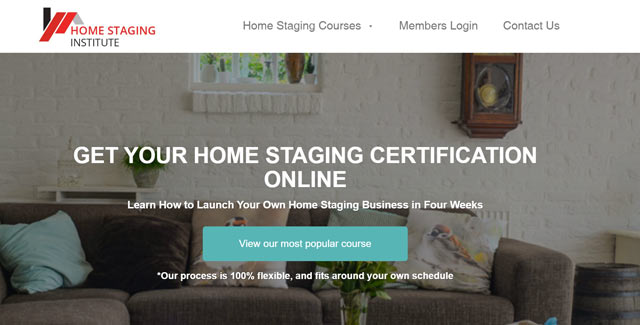
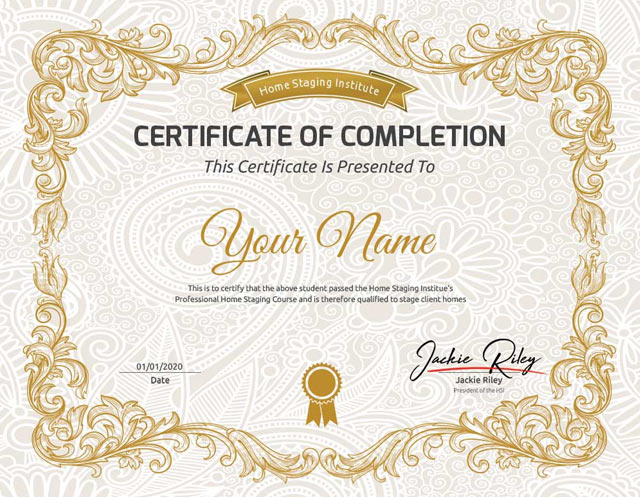
Step 5: Start a Home Staging Business

Since you’re reading a guide on how to become a home stager, there’s a good chance you’re already thinking ahead to starting your own business. That could mean working part-time around your current job, or diving all-in and building a full-service home staging brand with a small team.
Either way, you’ll want to lay the right groundwork.
By now, you’ve:
- Decided you want to become a home stager
- Learned the foundational principles of home staging
- Researched your local market and competitors
- Completed a home staging course to sharpen your skills
Now let’s walk through the practical steps to go from trained to paid.
Step 1: Create a Home Staging Website and Portfolio
You don’t need a fancy $5,000 website to start booking clients. Honestly, we discourage it. At the beginning, keep it simple. Platforms like Wix, Squarespace, and even Canva websites are more than enough. Focus on clarity, not complexity.
Make sure your site includes:
- A brief introduction about who you are
- A list of your services and pricing (or at least a starting price)
- Before-and-after photos of your work
- A contact form so people can easily reach you
If you completed a home staging course through us, use your final project photos to seed your portfolio. If you need more variety, stage a room in your own home or offer to help a friend or family member prepping for a sale. Take high-quality photos and explain what staging decisions you made and why.
One of our students, Sofia in Arizona, started by staging her cousin’s home before it went on the market. She posted those photos on Instagram with a link to her simple Squarespace site. Her first paid client came two weeks later through a realtor who had seen the transformation on social media.
If you’re confident on camera, consider a short video walkthrough of a staged room talking through your staging choices. This builds trust and authority instantly.
Step 2: Decide on Your Pricing Model
We’ve covered pricing in detail elsewhere, but here’s a recap:
- Start by researching what others in your area are charging.
- Expect to set fees for consultations, per-room staging, and vacant home packages.
- Don’t underprice yourself. Clients equate price with value.
A student named Thomas in Melbourne began with $150 consultation fees, but quickly realized that after travel, planning, and follow-up emails, he was only earning around $18/hour. He raised his rate to $300 and began offering add-ons like digital staging suggestions and accessory packages. Clients responded positively – and his profit tripled with very little extra effort.
The point is, your pricing should reflect your time, talent, and travel. Be clear, be fair, and be firm.
Step 3: Source Your Staging Inventory
Here’s the golden rule: don’t buy a full storage unit of furniture before you’ve booked your first client.
Most new stagers use a mix of:
- Client’s existing furniture
- Rented furniture (especially for vacant homes)
- Owned accessories (cushions, lamps, art, throws)
Start small. A well-curated stash of accessories from budget stores like HomeGoods, Kmart, or Facebook Marketplace can go a long way.
Explore local furniture rental companies and take note of minimum rental terms, styles available, and delivery costs. Add your go-to suppliers to a shared Google Doc so you can scale up quickly as needed.
Step 4: Get Your Legal and Operational Documents in Order
The business side of things can feel boring – but it’s essential.
If you took our course, you’ll already have access to templates for:
- A home staging contract
- A home staging company business plan
- Proposal documents
- Checklists
- Invoicing templates
- etc etc
If not, you’ll need to create or buy your own. We recommend keeping everything in Google Docs or Sheets so you can easily update and access your files from anywhere.
Don’t forget to review your contracts with a legal professional – especially if you’re dealing with furniture, clients’ homes, and service providers. A clear agreement sets expectations and protects you from miscommunication.
Also look into basic bookkeeping software. Even a free tool like Wave or a simple spreadsheet will help you stay on top of income, expenses, and tax deductions.
Step 5: Understand Licensing and Insurance Requirements
You don’t need a license to become a home stager, but you do need to treat this like a legitimate business. That often means registering a business name, getting a local business license, and sorting out insurance.
- Start by checking with your city or state about business license requirements.
- Set up your business as a sole proprietorship or LLC (depending on your situation).
- Get liability insurance. This protects you in case anything gets damaged on a job.
Anna, a student from Ontario, skipped the insurance step at first – until a vase broke during a last-minute staging. Luckily, the homeowner was understanding, but it was a wake-up call. She’s now fully covered and says the peace of mind is worth every penny.
Step 6: Commit to Ongoing Education and Inspiration
If you want longevity in this business, you need to keep evolving.
That means continuing to learn:
- Enroll in advanced courses or refreshers
- Attend local real estate or design expos
- Subscribe to interior design magazines or blogs
- Pay attention to color trends, furniture styles, and buyer behavior
Keep an eye on what top-tier staging companies are doing. Screenshot clever ideas, save inspiring Instagram reels, and walk through display homes. You’ll pick up ideas you can use and personalize.
One graduate of our Advanced Course, Michelle in Auckland, blocks off two hours each week just to learn. Sometimes that means watching interior design YouTube videos, sometimes it’s visiting open homes to observe flow and layout. Her business continues to thrive because she treats her creativity like a muscle.
Step 6: Begin Marketing Your Business
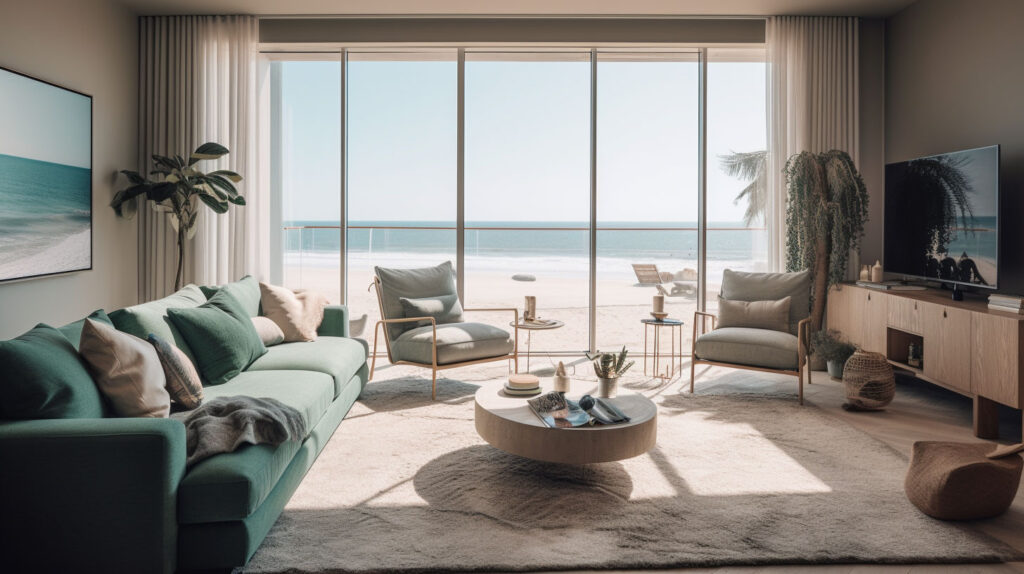
Completing a home staging course is one of the easiest ways to instantly add credibility to your new business. It gives you confidence, a structured approach, and a professional edge – especially when paired with a certification that you can proudly feature on your website, emails, and marketing materials.
You can earn your home staging certification entirely online, often in just a few weeks. These courses don’t just teach staging – they show you how to package and present yourself as a professional. That’s powerful in a market where clients are often comparing you against others with more years under their belt.
Although this guide is all about how to become a home stager, we’d be doing you a disservice if we didn’t at least skim the surface of marketing. After all, your staging skills are only half the equation. The other half? Making sure the right people know you exist.
Let’s walk through the most effective marketing strategies for home stagers.
Networking with Realtors
When your marketing budget is small (and let’s face it – it probably is), building relationships will be your highest ROI activity. Realtors are your best referral source. They work with homeowners every day and have a vested interest in getting listings sold quickly and for top dollar.
That means it’s in their best interest to know a great home stager.
Attend local real estate meetups, open houses, or chamber of commerce events. Introduce yourself, bring along a one-page portfolio, and follow up with a friendly email afterward. Even if they don’t need you now, you’ll be top of mind when they do.
Danielle, a recent student from Toronto, reached out to ten local agents with a short, personalized email and an offer to stage their next tricky listing at a discounted rate. Three replied. One turned into a full-price client, and that one relationship led to six more referrals within two months. Why? Because Danielle made it easy, friendly, and professional from the get-go.
If you’re more comfortable behind the keyboard, connect on LinkedIn and comment on their posts before reaching out. And whatever you do – make sure your website and social profiles are polished before you make first contact.
Digital Marketing That Delivers
When you first launch your staging business, your website is likely a ghost town. No one is visiting, and you probably aren’t ranking on Google just yet. That’s totally normal. Building organic traffic takes time.
That’s where Google Ads come in.
With as little as $5–10 a day, you can show up right at the top of search results for people looking for a stager in your area. This is one of the most effective marketing methods for new home stagers.
Be precise with your keyword targeting. Instead of bidding on generic phrases like “home stager,” use specific terms like:
- home staging san diego
- portland home stager near me
- property staging company Melbourne
- staging consultation new orleans
These people are actively looking for your service right now. Meeting them with a clean, helpful website is one of the fastest ways to get your first few clients.
We had a student, Josh in Florida, who ran $100 of Google Ads in his first month. That spend landed him a single consult – which turned into a $3,200 full staging job. He now runs $300/month in ads consistently and says it’s his single best lead source.
Other Proven Ways to Market Your Home Staging Business
Let’s go beyond the basics. These methods are slightly more advanced but can give you a real edge if you’re consistent:
- Instagram Portfolio & Reels – Visual platforms are made for home stagers. Post before-and-after photos, time-lapse videos of your setup process, and walk-throughs of finished homes. Add local hashtags to help people find you. Realtors often check Instagram to vet potential vendors.
- Local Facebook Groups – Join neighborhood or city-specific Facebook groups where people share referrals for trades and services. Introduce yourself, share a win or a recent transformation, and don’t be salesy—just helpful and visible.
- SEO for Long-Term Success – Over time, optimize your website to appear in search results organically. Start a blog with topics like “5 Ways to Sell Your Home Faster” or “Why Home Staging Works.” Add your city name into the titles and meta descriptions. It’ll take a few months, but the long-term payoff is steady traffic without ad spend.
- Flyers & Leave-Behinds – When you’re visiting real estate offices or attending networking events, bring along high-quality printed flyers, a lookbook, or even a small thank-you gift with your branding. These old-school methods still work because they stand out in an online world.
- Build an Email List – Start collecting emails from every consultation, inquiry, or website visitor. Send monthly updates, recent projects, and tips for staging success. You’ll stay top-of-mind for future referrals.
- Partner with Photographers – Real estate photographers often know when homes are looking their best—and when they’re not. Teaming up with one can lead to great referrals, plus you’ll get beautiful imagery for your own portfolio.
You don’t have to do it all at once. Pick two or three methods to start and do them really well. Then layer in others as you grow.
And remember, great marketing doesn’t have to be expensive – it just has to be intentional. The key to success is staying visible, being helpful, and showing off what you can do. If people can’t find you, they can’t hire you.
So get out there, introduce yourself, and start showcasing your talent. The clients will follow.
Final Thoughts on How to Become a Home Stager and Launch a Business
Starting a home staging business is a blend of design, logistics, people skills, and a whole lot of motivation. When you learn how to become a home stager through training and experience, and then actually put that knowledge into practice with your first few clients, you start to gain momentum.
Make it real. Launch the website. Set the pricing. Reach out to a realtor. Offer to stage a friend’s house. Take photos.
Before you know it, you’re not just thinking about staging—you’re doing it. And getting paid.
Let’s keep going. You’re closer than you think.
State Specific Guides
If you’re wondering how to become a home stager in your state, you’re in the right place.
Each of our state-specific guides breaks down the unique details you’ll need to know – from local market conditions and licensing rules to how stagers typically market themselves in your area.
Whether you’re in Texas, California, or anywhere in between, these guides will help you understand what it’s really like to launch a staging career where you live.
Frequently Asked Questions

It takes as little as 1 month to become a certified home stager and begin your career. The main requirements for becoming a home stager are a good eye for interior design, and knowledge of how the industry works. There is no degree or university education required to operate as a home stager in the United States, Canada, UK, Australia, or New Zealand.
Legally, you do not need any qualifications to be a home stager in the United States, Canada, UK, Australia, and New Zealand. Qualifications and certifications in this industry will help you learn the art of home staging and give you insights into running a home staging business, but are not a requirements.
To become a home stager in the UK you simply need to learn the art of home staging, or have similar knowledge in a related field such as interior design. Most providers of home staging certification, including here at the Home Staging Institute, provide a certificate upon completion which proves to employers in the UK that you have undertaken some form of education which can fast track you into your first home staging job.
The process to become a home stager in Canada is much the same as it is in other countries. You need to finetune your eye for design, and considering supplementing your natural ability with a form of education or certification. There are no legal requirements to becoming a home stager in Canada, and anyone can start their own home staging business.
No, you do not need a degree to be a home stager. There are no formal training requirements to become a home stager, although employers in this industry may look favorably on applicants that home some form of certification in home staging or a degree in related fields such as interior design.
The process of becoming a home stager in Texas is just the same as any other state, in terms of qualifications and education required. As with all states, you do not need any form of university education to become a home stager in Texas.
To become a certified home stager you need to complete some form of training in this field, and pass an exam to show you have a good understanding of the topic. Here at the Home Staging Institute we have been providing home staging certifications online for over 13 years, but there may also be local classes if you would prefer an in-person experience.
Our recommended approach to get into home staging is a three pronged approach. Firstly, finetune your eye for design by looking at and visiting property for sale, and taking mental notes about what you would do to improve the property. Secondly, undertake some form of home staging training either online or in person, and thirdly try to get experience in the industry working for an established home staging company. Once you are confident staging homes, and understand how the industry works, then you can consider starting your own home staging business.
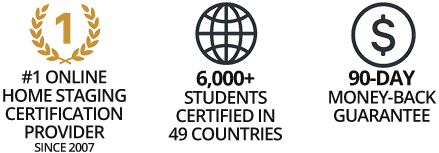
Ready to Take Your Home Staging Skills to the Next Level?
At the Home Staging Institute, we specialize in helping people turn their love of decorating into a rewarding career. If you enjoyed learning about the topic in this blog post, you’ll love what’s inside our Home Staging Certification Courses. They’re 100% online, self-paced, and packed with practical tools, templates, and real-world advice to help you succeed.
Join thousands of students from around the world who’ve trusted us to help them become certified home stagers.


